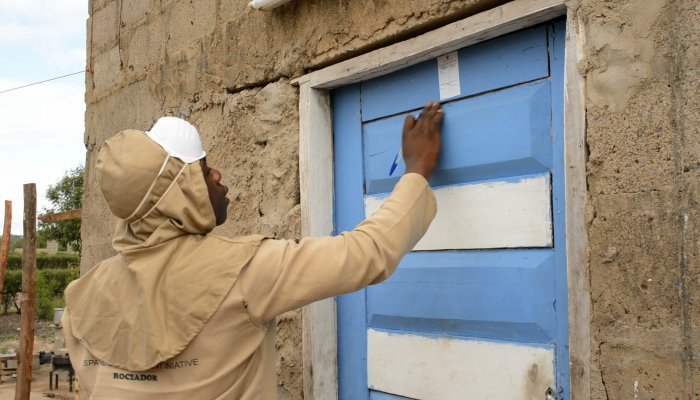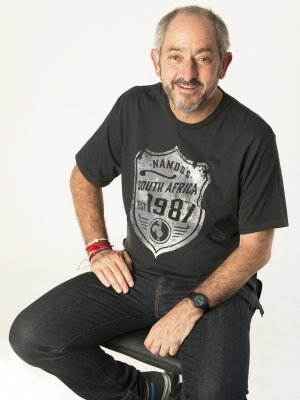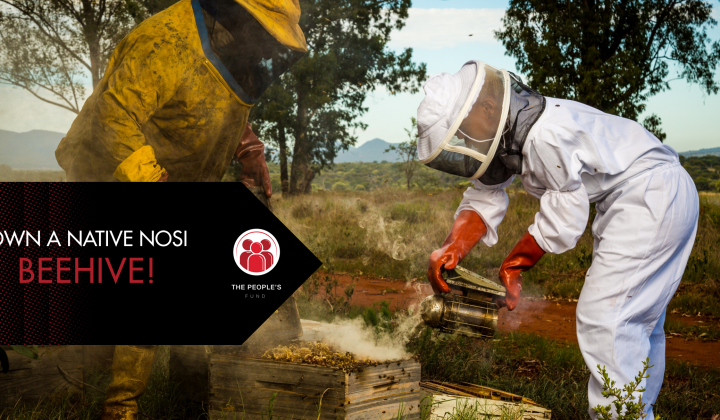It’s 11 a.m. in the small Mozambican town of Boane, and the temperature is already 35 degrees, with the humidity at 90%. In the sweltering heat Silvia Simao, wearing overalls and boots, a face mask and shield, and carrying a spray pump weighing 20 kg, is busy spraying the indoor walls of a house with insecticide. She’s part of a team of 150 sprayers that work six days a week to reduce malaria in Boane, which is also the name of the district. Her team has a massive and important job ahead of them over the coming months. Collectively they will spray 55 947 houses in Boane, protecting 120 000 people from malaria.
Silvia and her co-workers are part of a team assembled by an unlikely coalition that includes the Global Fund to fight AIDS, tuberculosis and malaria (GF), the governments of Mozambique, South Africa and Swaziland (MOSASWA) and a South African initiative, Goodbye Malaria, which is heavily backed by Nando’s Robbie Brozin, along with co-founders of the initiative, Sherwin Charles and Kim Lazarus.
The goal of the coalition is to eradicate malaria in the region completely and, for once, the prospect of success looks encouraging. Over the last three years the incidence of malaria in Boane has dropped from 13.75% to a remarkable 1%.
A new approach to malaria elimination in Africa?
Started in 2013, Goodbye Malaria - a social benefit organisation - has been working hard to raise awareness and funding for malaria elimination programmes in Mozambique. Supported by international restaurant group Nando’s - which provided the initial capital to set up the organization - as well as other corporate partners, Goodbye Malaria uses a community development model to mobilise funds and advocate against malaria, while creating employment opportunities at the same time.
A recent public private partnership initiated between Goodbye Malaria, the Global Fund and the governments of MOSASWA, has brought hope for a new collective impact model that will ramp up malaria elimination activities in the region, saving millions of lives while providing much-needed employment opportunities for people living in affected communities at the same time.
A grant, totaling $9.78 million, was awarded to the Lubombo Spatial Development Initiative 2 (LSDI2), a Goodbye Malaria initiative, by the Global Fund earlier this year. What makes this grant different is that it’s the first to be co-founded by both the Global Fund and the private sector (through Goodbye Malaria), thereby connecting the global malaria community with local government and the private sector, in a coordinated effort to eliminate the disease.
The Global Fund, together with the private sector, hopes that this grant will change the landscape of the how the global community tackles and solves social issues around the globe. Part of the grant is an agreement that Goodbye Malaria will contribute $4 million, from the private sector. Nando’s, a long-time supporter of Goodbye Malaria, has committed to provide the major portion of this funding,” says Sherwin Charles, CEO of Goodbye Malaria.
Goodbye Malaria’s flagship programme is the LSDI2, a cross-border, regional programme working in South Africa, Swaziland and Mozambique, and has been operating since 2013. The programme works directly with the Mozambican Health Department’s National Malaria Control Programme in a unique public-private partnership.
Mozambique, as a high malaria transmission country, shares 3% of the global malaria burden while Swaziland and South Africa are low transmission countries. This makes it a strategic area to tackle if elimination in Southern Africa is to be achieved. Most of the work undertaken by the LSDI2 programme is therefore focused on Southern Mozambique, in Maputo Province.
The key malaria intervention of the programme is Indoor Residual Spraying (IRS). Not only does it protect the community from malaria but sprayers are recruited locally, creating much-needed employment and improving the efficiency of the programme as they are both familiar with the local terrain, and known to community members. LSDI2 has employed over 400 local Mozambicans during the past year alone, more than 50% of which are women.
Initially starting in Boane in 2013, the programme was rolled out to include the districts of Magude in 2014 and Marracuene in 2016; while Manhica and Moamba have been added for the current spray season. A target of 205 781 houses to be sprayed, protecting 588 195 people across the five districts, has been set for 2017/2018.
The socio-economic burden of malaria
While half the world’s population is at risk of contracting malaria, nowhere has the disease exacted a greater toll than in Africa. By virtue of weather, ecology and poverty, 90% of the 212 million cases reported, and 92% of the 429 000 malaria related deaths recorded in 2015, occurred in Africa. Sub-Saharan Africa is most effected, with thirteen countries in the region accounting for 76% of malaria cases, and 75% of malaria related deaths, globally.
In countries like Mozambique, where infection rates are high, the poor are impacted the most. Households in Africa are estimated to lose up to 25% of their income to the disease, perpetuating the cycle of poverty, while there are also significant implications for companies through workforce absenteeism and reductions in overall company productivity.
Children under the age of five are most susceptible to illness and death, with 70% of all malaria deaths occurring in this age group. According to the WHO, malaria remains a major killer of children under five years old, taking the life of a child every two minutes. For those that do survive, malaria accounts for 15% of health-related absenteeism from schools, and impairs as much as 60% of schoolchildren’s learning ability in endemic areas.
It is estimated that malaria has cost sub-Saharan Africa US$ 300 million each year since 2000 for case management alone, and up to 1.3% of Gross Domestic Product (GDP) annually. It could be controlled, and treated, for much less.
Collaboration, innovation, elimination
By taking a collective impact approach in Mozambique the new partnership between the Global Fund, Goodbye Malaria and the governments of MOSASWA, hopes to provide an innovative template for malaria control and elimination programmes that can be replicated across Africa.
By leveraging off the strengths of the various partners, and working collaboratively, the aim is to accelerate from malaria control to pre-elimination in southern Mozambique while at the same time accelerating the transition from pre-elimination to elimination in Swaziland and South Africa. A target of achieving zero local transmission in Swaziland, South Africa and Maputo province by 2020, and achieving pre-elimination status elsewhere in southern Mozambique by 2025, has been set.
Not only is the programme innovative in its structure, but also in its activities. By taking a business mind-set and using it to drive efficiencies to maximise impact, Goodbye Malaria has improved the standard model of an IRS programme. This includes using detailed data driven dashboards to aid management with monitoring operations; the development of a smart phone application with GPS tracking of where and how many homes have been sprayed; training and hiring practices which pay close attention to local customs and sensitivities; and detailed management supervision and development of processes leading to best in class coverage percentages.
By the end of 2016 Goodbye Malaria reported it had cumulatively protected more than 350,000 people across the districts of Boane, Magude and Marracuene in southern Mozambique, through IRS. The number of malaria cases has dropped significantly with a 46% decrease in Boane, 89% decrease in Magude and 43% decrease in Marracuene.
The recently awarded Global Fund grant will allow Goodbye Malaria to ramp up its activities, protecting 2,7 million people cumulatively in the MOSASWA region from malaria while employing over 1,400 local people in the process.
The success of the programme will be measured by the Global Fund on the number of confirmed malaria cases in Mozambique, South Africa and Swaziland; the proportion of households in the targeted regions receiving IRS; and all four of South African and Swaziland’s border health posts being operational and reporting information into the National Health System.
Building on past gains and new partnerships for success
The number of people that have died from malaria in Africa has almost halved since 2000. However, while global funding for malaria has increased to US$2.9 billion per year, it’s less than half the amount needed to maintain the gains made against the disease.
When control activities are neglected a resurgence of the disease can occur within just one infectious season. Given the recent plateau in development partner support for such programmes, against the backdrop of many other critical global priorities, African governments must play a bigger role in securing diverse sources of funding to ensure the sustainability and stability of their malaria control efforts.
The public-private partnership model currently being followed by the Global Fund, Goodbye Malaria and MOSASWA, with its unique combination of resources, expertise and commitments, brings promise of a new approach other regions across the continent can adopt so Africa may say ‘goodbye’ to malaria once and for all.
The importance of achieving malaria elimination right on the continent cannot be over-emphasized or underestimated. Africa’s people are its hope and future, and their health and well-being is critical if they are to build and advance the continent to the next level of economic progress and security.
Malaria is transmitted through the bite of a female Anopheles mosquito, known as "night-biting" mosquitoes as they typically bite between dusk and dawn, which are infected with one of several plasmodium parasites. Infection results in an acute febrile illness with symptoms including fever, chills and a headache. While preventable and treatable, if not treated malaria quickly becomes life-threatening by disrupting the blood supply to vital organs.
Indoor Residual Spraying (IRS) involves the spraying of a residual insecticide on the interior walls of houses that serve as a resting place for mosquitos. Mosquitoes die when they come in contact with treated surfaces, preventing disease transmission. The potential of IRS is only realised when at least 80% of the houses within a targeted area are sprayed. It is effective for three to six months depending on what type of insecticide is used and the type of surface on which it is sprayed.
Info Box 3: Goodbye Malaria raises funds for its malaria programme in Mozambique by selling a range of African inspired products, made by South African entrepreneurs and small businesses, including hand-beaded bracelets and jewellery, shirts, pyjamas and teddies which are sold to individuals and corporations. Visit https://www.goodbyemalaria.com/shop to “Save a life in your sleep”.
...for once, the prospect of success looks encouraging....
...nowhere has the disease exacted a greater toll than in Africa...
Not only is the programme innovative in its structure, but also in its activities.








